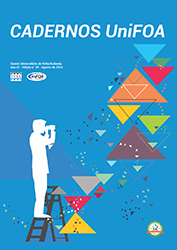Modelagem cinemática direta de braço robótico planar com 2 graus de liberdade
aplicação dos parâmetros de Denavit-Hartenberg
DOI:
https://doi.org/10.47385/cadunifoa.v20.n55.5672Keywords:
Forward kinematics, Denavit-Hartenberg, Robotics, Planar manipulator, Computational simulationAbstract
This work presents the implementation and analysis of the forward kinematic modeling of a planar robotic arm with two degrees of freedom (2-DOF). The study employs the Denavit-Hartenberg parameters to establish the coordinate system and perform the geometric transformation necessary to determine the end-effector’s final position. The proposed methodology uses computational tools in Python for three-dimensional visualization and calculation of the Cartesian coordinates of the manipulator’s terminal point. The results demonstrate the effectiveness of the mathematical approach in solving the forward kinematics problem, providing a didactic and practical tool for analyzing robotic systems. The model was validated through numerical simulations, confirming the accuracy of the kinematic calculations and the suitability of the 3D graphical representation for analyzing the manipulator's workspace.
Downloads
References
ANGELES, J. Fundamentals of Robotic Mechanical Systems: Theory, Methods, and Algorithms. 3. ed. New York: Springer, 2007. DOI: https://doi.org/10.1007/978-0-387-34580-2
CORKE, P. Robotics, Vision and Control: Fundamental Algorithms in MATLAB. 2. ed. Berlin: Springer, 2017. DOI: https://doi.org/10.1007/978-3-319-54413-7
CRAIG, J. J. Introduction to Robotics: Mechanics and Control. 4. ed. Boston: Pearson, 2017.
DENAVIT, J.; HARTENBERG, R. S. A kinematic notation for lower-pair mechanisms based on matrices. Journal of Applied Mechanics, v. 22, n. 2, p. 215-221, 1955. DOI: https://doi.org/10.1115/1.4011045
GOLUB, G. H.; VAN LOAN, C. F. Matrix Computations. 4. ed. Baltimore: Johns Hopkins University Press, 2013.
HARRIS, C. R. et al. Array programming with NumPy. Nature, v. 585, n. 7825, p. 357-362, 2020. DOI: https://doi.org/10.1038/s41586-020-2649-2
HIGHAM, N. J. Accuracy and Stability of Numerical Algorithms. 2. ed. Philadelphia: SIAM, 2002. DOI: https://doi.org/10.1137/1.9780898718027
HUNTER, J. D. Matplotlib: A 2D graphics environment. Computing in Science & Engineering, v. 9, n. 3, p. 90-95, 2007. DOI: https://doi.org/10.1109/MCSE.2007.55
KHALIL, W.; DOMBRE, E. Modeling, Identification and Control of Robots. 3. ed. London: Kogan Page Science, 2002. DOI: https://doi.org/10.1016/B978-190399666-9/50014-2
LYNCH, K. M.; PARK, F. C. Modern Robotics: Mechanics, Planning, and Control. Cambridge: Cambridge University Press, 2017. DOI: https://doi.org/10.1017/9781316661239
MCKINNEY, W. Python for Data Analysis: Data Wrangling with Pandas, NumPy, and IPython. Sebastopol: O'Reilly Media, 2012.
MURRAY, R. M.; LI, Z.; SASTRY, S. S. A Mathematical Introduction to Robotic Manipulation. Boca Raton: CRC Press, 1994.
NAKAMURA, Y. Advanced Robotics: Redundancy and Optimization. Boston: Addison-Wesley, 1991.
SCIAVICCO, L.; SICILIANO, B. Modelling and Control of Robot Manipulators. 2. ed. London: Springer-Verlag, 2000. DOI: https://doi.org/10.1007/978-1-4471-0449-0
SICILIANO, B. et al. Robotics: Modelling, Planning and Control. London: Springer, 2009. DOI: https://doi.org/10.1007/978-1-84628-642-1
SPONG, M. W.; HUTCHINSON, S.; VIDYASAGAR, M. Robot Modeling and Control. 2. ed. Hoboken: John Wiley & Sons, 2020.
VAN DER WALT, S.; COLBERT, S. C.; VAROQUAUX, G. The NumPy array: a structure for efficient numerical computation. Computing in Science & Engineering, v. 13, n. 2, p. 22-30, 2011. DOI: https://doi.org/10.1109/MCSE.2011.37
VAN ROSSUM, G.; DRAKE, F. L. Python 3 Reference Manual. Scotts Valley: CreateSpace, 2009.
YOSHIKAWA, T. Foundations of Robotics: Analysis and Control. Cambridge: MIT Press, 1990. DOI: https://doi.org/10.7551/mitpress/3074.001.0001
Downloads
Published
How to Cite
Issue
Section
License
Copyright (c) 2025 Cadernos UniFOA

This work is licensed under a Creative Commons Attribution-NonCommercial-ShareAlike 4.0 International License.
Declaração de Transferência de Direitos Autorais - Cadernos UniFOA como autor(es) do artigo abaixo intitulado, declaro(amos) que em caso de aceitação do artigo por parte da Revista Cadernos UniFOA, concordo(amos) que os direitos autorais e ele referentes se tornarão propriedade exclusiva desta revista, vedada qualquer produção, total ou parcial, em qualquer outra parte ou meio de divulgação, impressa ou eletrônica, sem que a prévia e necessária autorização seja solicitada e, se obtida, farei(emos) constar o agradecimento à Revista Cadernos UniFOA, e os créditos correspondentes. Declaro(emos) também que este artigo é original na sua forma e conteúdo, não tendo sido publicado em outro periódico, completo ou em parte, e certifico(amos) que não se encontra sob análise em qualquer outro veículo de comunicação científica.
O AUTOR desde já está ciente e de acordo que:
- A obra não poderá ser comercializada e sua contribuição não gerará ônus para a FOA/UniFOA;
- A obra será disponibilizada em formato digital no sítio eletrônico do UniFOA para pesquisas e downloads de forma gratuita;
- Todo o conteúdo é de total responsabilidade dos autores na sua forma e originalidade;
- Todas as imagens utilizadas (fotos, ilustrações, vetores e etc.) devem possuir autorização para uso;
- Que a obra não se encontra sob a análise em qualquer outro veículo de comunicação científica, caso contrário o Autor deverá justificar a submissão à Editora da FOA, que analisará o pedido, podendo ser autorizado ou não.
O AUTOR está ciente e de acordo que tem por obrigação solicitar a autorização expressa dos coautores da obra/artigo, bem como dos professores orientadores antes da submissão do mesmo, se obrigando inclusive a mencioná-los no corpo da obra, sob pena de responder exclusivamente pelos danos causados.










